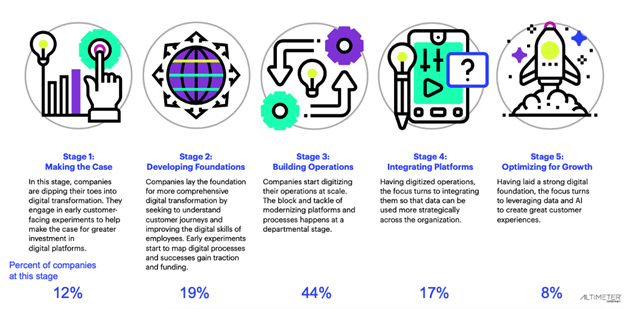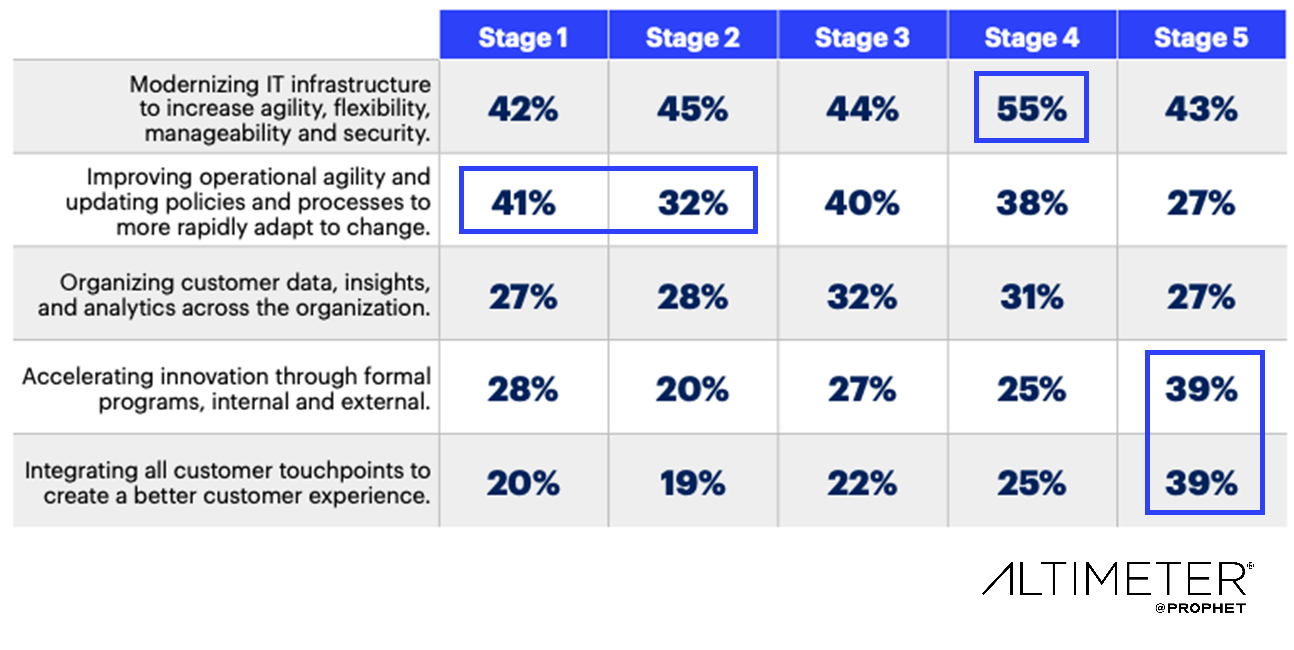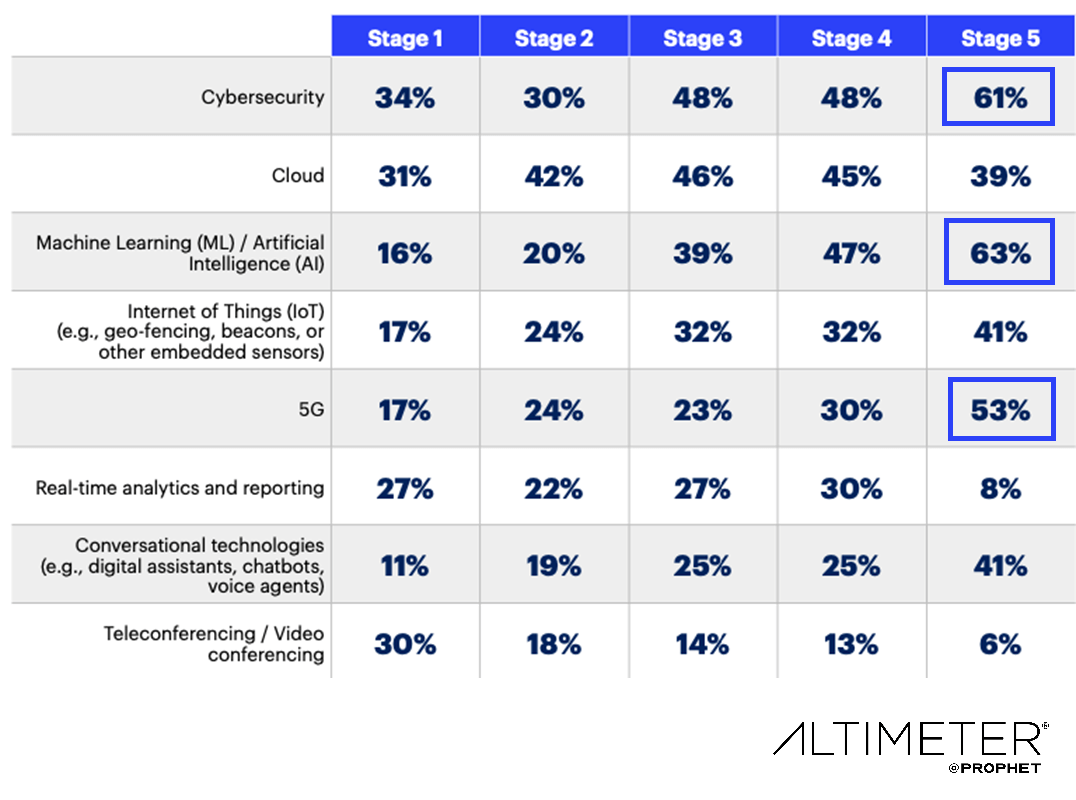BLOG
Your Digital Maturity Is the Best Way to Evaluate Technology Vendors
Our research shows that it’s time for a maturity-based approach to technology development and selection.
One of the biggest challenges for organizations pursuing digital transformation is parsing through the myriad of digital solutions available. For example, I’ve been diving into the world of customer data platforms (CDPs) for the past few weeks and it’s a dizzying array of jargon and solutions.
One approach is to reference the technology evaluations from analyst firms like Gartner’s Magic Quadrant and Forrester’s Wave — but those are already several years old. There are also several peer-based evaluation and review sites like Capterra, Gartner’s PeerInsights, Trust Radius, which can be filtered by reviews from by company size, industry, and region in some cases.
But I think they all miss one major factor when it comes to selecting technology — digital maturity. Our research at Altimeter found that digital maturity drove substantial differences in not only the strategic objectives and initiatives of digital transformation but also in technology priorities. And yet, the element of digital maturity rarely factors into the selection process or shows up in the marketing of these solutions.
“Digital maturity drove substantial differences in not only the strategic objectives and initiatives of digital transformation but also in technology priorities.”
What’s missing is a maturity-based approach to technology development and selection. Organizations can be better prepared to discuss their needs by understanding their digital maturity and knowing how they will evolve their technology stacks over time. And vendors could clear out much of the confusion in the marketplace by making clear not just how they help organizations but where and when they best do this throughout the transformation journey.
In this post, I’ll review how digital maturity impacts digital transformation and provide specific recommendations for both organizations and technology vendors.
Digital Maturity’s Impact on Digital Transformation Strategy
Let’s take a deeper dive into how digital maturity impacts technology selection. In our State of Digital Transformation 2020 report, we identified five stages of digital maturity relevant to digital transformation (see Figure 1). Most organizations are at Stage 3, focused on the digital transformation specific departments and hoping to move to Stage 4 where they start to knit and integrate across department silos.
Figure 1: The Five Stages of Digital Transformation Maturity

We also found that the top initiatives differed substantially depending on maturity levels. For example, organizations in Stage 4 prioritize modernizing IT at substantially higher levels (55%) than other organizations because of their focus on updating legacy platforms for better integration across the enterprise (see Figure 2).
In contrast, Stage 1 and Stage 2 organizations prioritize operational ability (41% and 32% respectively), especially around updating policies and processes. And organizations at Stage 5 of digital maturity indicate that accelerating innovation (39%) and integrating customer touchpoints (39%) are among their top initiatives because they’ve already done the heavy lifting of digitizing and integrating their operations.
Figure 2: The Top Five Digital Transformation Initiatives by Digital Maturity Stage

Given that digital transformation initiatives differ by digital maturity, the technology priorities also vary significantly depending on maturity. More advanced in their usage of and reliance upon data, Stage 5 organizations are more likely to focus their investments on technologies that support cohesive, data-enabled initiatives — such as machine learning/artificial intelligence, cybersecurity, and 5G to (see Figure 3). But differentiation based on AI/ML or conversational technologies will matter less to organizations in earlier stages of maturity as they are still getting their data backends in order.
Figure 3: The Top Technology Investment Priorities for 2020 by Maturity Stage

What It Means
If you’re an organization going through digital transformation:
- Assess your digital maturity. Know where you are starting and very importantly, align across your department and organization on where you are. To get started, take Altimeter’s Digital Maturity Assessment and benchmark it against the other 628 companies we surveyed.
- Audit your strategy and roadmap. Once you know the stage of your digital maturity, examine your digital transformation strategy, especially the focus and sequencing of initiatives. How long will you need to wait for more departments to reach a critical level of digital maturity before moving forward with integration plans? Where are you missing critical capabilities? And timing is everything. Layout how major initiatives unfold over the next 18-36 months by quarters to ensure that everyone understands the roadmap.
- Begin conversations with vendors differently. Instead of asking what they do, explain your roadmap so that they understand where you are today and where you are heading. Favor vendors who understand how to support your initiatives as your maturity and needs change. If the vendor doesn’t acknowledge or address your digital maturity stage, then walk away and quickly. Statements like “We serve every stage!” or “We can evolve with you!” reveal that they haven’t done the heavy lifting of truly understanding how you will evolve. Instead,
- Resist the urge to buy technology ahead of when you are ready to use it. It’s tempting to invest in the “best” technology platforms, especially when they offer features like real-time personalization or AI-driven predictive analytics. But if your organization lacks the expertise and procedures to use these amazing features, you’ll be paying for wasted capabilities. Worst case, the platform is so complicated that few people end up using it. The alternative is to use a less sophisticated platform but one that is right-sized for your needs for the next 6-18 months. While platform vendors will raise the specter of switching and integration costs in the future, trade off the opportunity costs of slower and lower adoption rates.
For technology vendors, there are three ways to better address the evolving digital transformation needs of organizations:
- Focus solutions on specific stages of their transformation journey. Resist the urge to say that your solution serves everyone and instead demonstrate you understand the priorities and needs at each stage of the journey. Instead of pitching AI and personalization features to Stage 1 and Stage 2 organizations, explain how dashboards deliver relevant KPIs to key executives.
- Highlight which stage you serve best. While it’s tempting to want to serve every company at every stage, you know where your sweet spot is. Put a big, bright spotlight on how you understand and address the needs of organizations at that maturity stage — and then explain why you can also support them going on to the next stage.
- Partner with vendors whose strengths complement yours. Knowing that you don’t serve all stages well will free you to find and partner with vendors who complement your offerings. Go beyond having APIs to craft deep integrations in marketing, sales, and service to develop go-to-market strategies. Make it easy to upgrade the technology stack and conversely, partner with someone who specializes in support organizations earlier in their transformation journey.
FINAL THOUGHTS
Taking digital maturity into account in your digital transformation strategy is crucial to your success. If you’d like to learn more about how Altimeter and Prophet can support you in assessing your digital maturity, updating your digital transformation strategy, or creating a technology roadmap, please connect with us.
